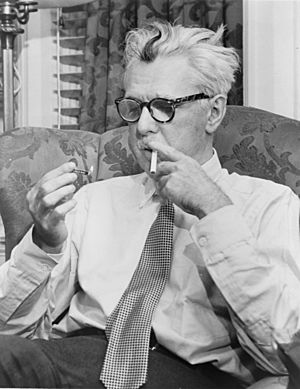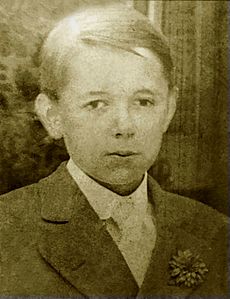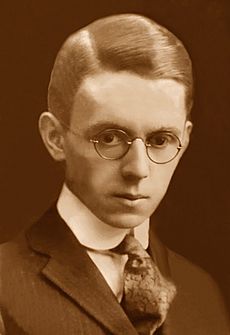James Thurber facts for kids
Quick facts for kids
James Thurber
|
|
|---|---|

Thurber in 1954
|
|
| Born | James Grover Thurber December 8, 1894 Columbus, Ohio, U.S. |
| Died | November 2, 1961 (aged 66) New York City, U.S. |
| Resting place | Green Lawn Cemetery, Columbus, Ohio, U.S. |
| Occupation |
|
| Period | 1929–1961 |
| Genre | Short stories, cartoons, essays |
| Subject | Humor, language |
| Notable works |
|
| Spouse |
Althea Adams
(m. 1925; div. 1935)Helen Wismer
(m. 1935) |
| Children | 1 |
James Grover Thurber (born December 8, 1894 – died November 2, 1961) was a famous American cartoonist, writer, and humorist. He was also a journalist and playwright.
Thurber was best known for his funny drawings (called cartoons) and short stories. Most of his work appeared in The New Yorker magazine. He also published many books.
He was one of the most popular humorists of his time. He often wrote about the funny problems and unique habits of everyday people. Many of his stories have been made into movies, like The Male Animal (1942) and The Secret Life of Walter Mitty (adapted in 1947 and 2013).
Contents
Life and Early Years
James Thurber was born in Columbus, Ohio, on December 8, 1894. His parents, Charles and Mary Agnes Thurber, greatly influenced his writing. His father worked as a clerk and was interested in politics. His mother was a very funny person and loved playing jokes.
When James was seven, he was playing a game with his brother. His brother accidentally shot him in the eye with an arrow. He lost that eye, and the injury later caused him to become almost completely blind. Because of this, he couldn't play many sports. Instead, he developed a very creative mind and used it for writing.
College Days and Early Career
From 1913 to 1918, Thurber went to Ohio State University. He was part of a fraternity and edited the student humor magazine, the Sundial. He never officially graduated because his poor eyesight kept him from taking a required military training course. However, he was given a degree from the university in 1995, after his death.
From 1918 to 1920, Thurber worked for the United States Department of State. He was a code clerk in Washington, D.C., and then at the U.S. embassy in Paris. After returning to Columbus, he became a reporter for The Columbus Dispatch newspaper from 1921 to 1924. He also reviewed books, films, and plays.
Moving to New York City
In 1925, Thurber moved to Greenwich Village in New York City. He got a job as a reporter for the New York Evening Post. In 1927, he joined the staff of The New Yorker magazine as an editor. His friend and fellow writer, E. B. White, helped him get the job.
Thurber's career as a cartoonist began in 1930. E. B. White found some of Thurber's drawings in a trash can and sent them to be published. Thurber contributed both his stories and his drawings to The New Yorker until the 1950s.
Family Life
Thurber married Althea Adams in 1922. They had a daughter named Rosemary. Their marriage ended in divorce in 1935. Later that year, he married Helen Wismer. They lived in Fairfield County, Connecticut.
Later Years and Passing
In his final year, Thurber's health declined. He suffered a blood clot on the brain in October 1961 and had surgery. He passed away a few weeks later, on November 2, at the age of 66, due to complications from pneumonia.
Legacy and Awards
- The annual Thurber Prize was started in 1997. It celebrates great examples of American humor writing.
- In 2008, one of Thurber's stories, "A Sort of Genius," was chosen for a collection of American True Crime stories.
- Two of the homes where he lived are now listed on the U.S. National Register of Historic Places. These are his childhood home, Thurber House in Ohio, and the Sanford–Curtis–Thurber House in Connecticut.
Thurber's Career as a Writer and Cartoonist
Thurber became famous for his simple, often strange, drawings and cartoons. His writing and drawing skills were greatly helped by E. B. White, who believed Thurber's sketches were works of art on their own. Thurber drew six covers and many classic illustrations for The New Yorker.
As a Writer
Many of Thurber's short stories are funny memories from his own life. But he also wrote some darker stories. His most famous short stories include "The Dog That Bit People" and "The Night the Bed Fell." These can be found in his popular book, My Life and Hard Times.
Other well-known stories are "The Secret Life of Walter Mitty" and "The Catbird Seat." He also wrote over seventy-five fables. These were short stories with talking animals, like "The Little Girl and the Wolf" (his version of Little Red Riding Hood). They usually ended with a moral or a funny lesson. His most famous fable is "The Unicorn in the Garden."
Thurber also wrote several book-length fairy tales, such as The White Deer (1945) and The 13 Clocks (1950).
He wrote many humorous essays for The New Yorker and other places. He often wrote about the English language, like in his piece "The Spreading 'You Know'," which talked about how often people use those words.
The last twenty years of Thurber's life were very successful, even though he was losing his eyesight. He published at least fourteen books during this time. These included The Thurber Carnival (1945) and The Years with Ross (1959), which was about the founder of The New Yorker.
As a Cartoonist
In the 1920s and 1930s, Thurber drew cartoons in the usual way. But as his eyesight got worse, he had to change how he worked. He drew on very large sheets of paper using a thick black crayon. Sometimes he used white chalk on black paper, and the colors were reversed for printing.
His cartoons became as famous as his writing. They had a unique, wobbly look that seemed to show his unusual way of seeing the world. He once said that people told him his drawings looked like they were done underwater. The last drawing Thurber finished was a self-portrait. It appeared on the cover of Time magazine in 1951.
Stories and Plays Made into Movies
Many of James Thurber's works have been adapted for the stage and screen:
- Thurber worked with his college friend Elliott Nugent to write The Male Animal. This funny play became a big hit on Broadway in 1939. It was made into a film in 1942, starring Henry Fonda.
- In 1947, his short story "The Secret Life of Walter Mitty" was made into a film. Danny Kaye played the main character.
- The 1959 film The Battle of the Sexes was based on Thurber's short story "The Catbird Seat".
- In 1960, Thurber himself appeared on stage in a show called A Thurber Carnival. It was based on his stories and cartoon captions. He even won a Special Tony Award for the script.
- From 1969 to 1970, a TV series called My World... and Welcome to It was broadcast. It was based on Thurber's writings and life. The show won an Emmy Award for best comedy series.
- In 2013, a new film version of The Secret Life of Walter Mitty was released, starring Ben Stiller.
See also
 In Spanish: James Thurber para niños
In Spanish: James Thurber para niños
- The Battle of the Sexes (1959 film) based on "The Catbird Seat"
- Walter Mitty, expression





